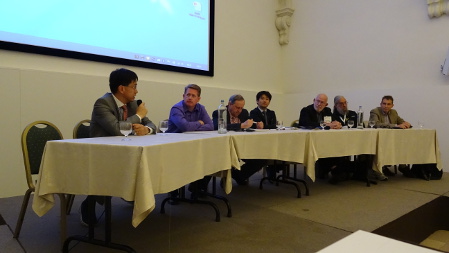ATSC 3.0’s Global Future is a Blank Slate
GHENT, BELGIUM - I spent the third week of June in Ghent, Belgium, attending and speaking at the IEEE BTS International Symposium on Broadband Multimedia Systems and Broadcasting, or BMSB as we refer to it. The vast majority of the material presented is research based papers from university engineering students from around the world. Much of the focus of their work are ways to enhance and improve broadcasting technologies. It’s actually kind of refreshing because it often seems that broadcasting technology is thought of as outdated or outmoded and on its last legs.
At the BMSB it was apparent that there are a wealth of creative young minds working on ideas and proposals that demonstrate that broadcast technology has a bright future if it is given the chance to evolve and adapt.
One of the most interesting technologies being presented was layered division multiplexing, or LDM. LDM technology is one of the proposals that has been submitted to the physical layer group within the ATSC TG3 for consideration in the ATSC 3.0 standard. LDM and ATSC 3.0 have attracted participation and research from around the world and there are no shortage of ideas, models and tests associated with the technology that demonstrate its effectiveness at providing terrestrial broadcast stations with an effective way to reach mobile devices, indoor receivers and traditional stationary viewers with a multiplicity of services up to and including UHD-1.
With my participation on the ATSC 3.0 standard, I have been hearing and reading about LDM since the first presentation I saw at a BTS Annual Broadcast Symposium a few years ago. Since then there have been numerous papers and presentations done, much of it available online. It is well worth the time to do a little research and read up on this technology because it will likely be a very important part of the future of broadcast television.

(From left to right) Wenjun Zhang, chief engineer, NERC-DTV; Luke Fay, ATSC TG3, PHY Layer chair, Sony; David Wood, consultant, innovation and technology, EBU; Kenichi Murayama, senior manager, planning & coordination, NHK; Bob Plummer, TV consultant; Rich Chernock, ATSC TG3 chair, Triveni Digital; Peter Siebert, executive director, DVB Project.
On November 11, 2011, I was in Shanghai for a summit on the future of broadcast television and the creation of the Future of Broadcast Television (FoBTV) group. The summit and the group that formed out of it united and agreed to work on a global broadcast television standard. Since the formation of FoBTV, the BMSB has consistently closed with a panel of leaders and luminaries from FoBTV and the industry to discuss the future and how things are progressing. I moderate the session. I like to ask tough questions about our progress and lack of progress, our technical challenges as well as our political challenges.
Each year, I see more and more that the technical challenges, while not inconsequential, pale in comparison to the political challenges. Each country involved seeks to manage its broadcasting resources to best meet the perceived needs of its population and the mission and political objectives of its government. This year was no exception. ATSC 3.0 has progressed and is on track to become a candidate standard in the near future. Since many of the participants working on ATSC 3.0 are also members of working groups and committees within FoBTV, they are moving in parallel.
However, the item that interested me the most this year was a technical decision with some peculiar ramifications. If you look under the hood of ATSC 3.0 you will find that some of the components are closely related to the DVB-T suite of technologies. As a matter of fact, some people within the technology committees thought that ATSC 3.0 was going to be DVB-T2 with an ATSC sticker over it. But when the decision was made to not constrain ATSC 3.0 to backward compatibility, the groups working on the standard were given a blank slate. Focusing on a broadcast standard that has a path for improvement and growth as part of a digital infrastructure that will include cellular smart devices and broadband connectivity as well as over-the-air reception, the decision was to move away from transport streams and instead embrace Internet protocol (IP) for carrying the data.
I remember being very happy when we reached this decision. Virtually every other part of the ecosystem that we are trying to move into is IP-based. Yet in my discussions with the panel it became obvious that in the DVB environment transport streams are the method of choice and there doesn’t seem to be any motivation to change. I guess I naively assumed that there would be a DVB-T3 that would move to IP-based delivery. I was a little disheartened to be told that there really isn’t much discussion going on in that area and that when IP was evaluated some time back, it didn’t provide enough benefit to be worth the change.
When the decision was made within ATSC to not be constrained to backward compatibility, one of the primary drivers was that the compromises that would have to be made to the capabilities of the new standard would be so great it wouldn’t be worth doing. Another primary driver was that if we stayed with what we have, the future outlook was bleak. So sitting still isn’t an option, nor is making an incremental change; so while the way forward is not as clear as we’d like, digging in and staying put isn’t a viable option either.
I am still hopeful that the group that is working on the next generation of broadcast technologies is creating a standard that has global potential, if not in this iteration then perhaps in the next. Anyone who thinks the transition of television broadcasting to digital stops when the analog service shuts down doesn’t understand the nature of digital technology.
Get the TV Tech Newsletter
The professional video industry's #1 source for news, trends and product and tech information. Sign up below.
Bill Hayes is the former director of engineering and technology for Iowa PBS and has been at the forefront of broadcast TV technology for more than 40 years. He’s a former president of IEEE’s Broadcast Technology Society, is a Partnership Board Member of the International Broadcasting Convention (IBC) and has contributed extensively to SMPTE and ATSC. He is a recipient of Future's 2021 Tech Leadership Award and SMPTE Fellow.

